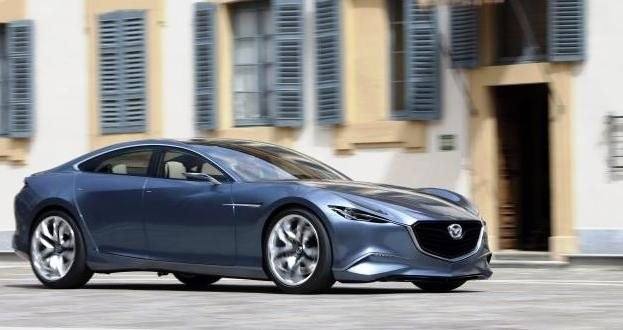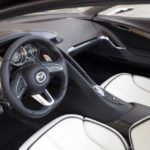With once established small car brands such as Hyundai seeking a higher spot in the automotive hierarchy developing V-8 powered premium vehicles, Japanese-based Mazda is, on the other hand, more content to make gains inside more modest frameworks. Working within tight styling confines, Mazda itself has long been searching to find its design path.
In past years, concepts like the Mazda Nagare and the Furai gave a passionate, futuristic window into possible shapes. Still, these one-off design studies are yet to significantly embody production vehicles. After more than a year as Mazda’s General Manager of Design, Ikuo Maeda is determined to see original Japanese-inspired motoring interpretations. “My goal is to create designs that people can point to proudly and say, ‘This is a Mazda design,’” Maeda says as he introduces the latest creation, the Mazda SHINARI.
As a four-door coupe concept, it appears that some influence has been drawn off European vehicles like Audi A7 Sportsback and Mercedes-Benz CLS. Some might argue that Japanese Mazda has beaten the Europeans to the punch with the configuration concept citing Mazda’s RX-8 is a four-door coupe. However, since the front doors need to be opened on the RX-8 before the rear doors, there are more passages than true rear passenger doors. The Mazda SHINARI four-door design is visually and functionally more in line with the premium European counterparts.

Recognized as Mazda’s new ‘KUDO- Soul of Motion’ design philosophy, the Japanese fashion’s intended goal is to formulate “a graceful and carefree form.” Capturing the powerful forces of nature through the vehicle’s sheet metal and glass, the Mazda SHINARI concept is assembled to convey the harmonious shaping of high-strength materials. Translating into the SHINARI’s design philosophy is the short, curvy snout of the Mazda RX-8 and the Mazda 6-style roof arching between the A and C-Pillars.
Apart from these features, which are presented in a much more observable manner on this latest concept vehicle, there is an abundance of unique aspects to the Mazda SHINARI design. Forgoing the smiling grille, the SHINARIi’s single intake placement is centered around shapely front fascia work. A forward-leaning look gives aggression to this four-door coupe enhanced by a fastback roofline.
So eloquently expressing speed on the outside, the interior arrangement of the Mazda SHINARI succeeds in reinforcing the car’s design theme. Entrusted to create an athletic feel for drivers and passengers, the four-door coupe is rounded with well-defined edges manufactured in aluminum and soft leather. When laying out the new Mazda concept’s controls, intent was placed into putting the driver into a cockpit. As the driver’s hands rest on a thick racing-style steering wheel, instruments are set in easy reach within a dedicated driver space.

Beyond the focus on creating a daring interior layout, technology takes center stage in the form of Mazda’s Human Machine Interface (HMI) brainchild. Presenting a three-dimension floating display, the SHINARI utilizes the HMI to offer the following three unique driving impressions: Business, Pleasure and Sport. In Business mode, occupants of the SHINARI are provided with connections to their workday, while the Pleasure setting brings entertainment and comfort controls to the forefront. In the Mazda SHINARI’s Sport mode, the car’s driving characteristics change, unlocking performance settings, including the paddle shifters. However, with the SHINARI being a design study only, there’s no powertrain to approximate exactly what kind of performance experience a driver can expect.
Unlike concept vehicles like the Nagare and Furai, there appears to be a deeper production car focus in play for the Mazda SHINARI concept study. This vehicle might be the unique identity Mazda has long been seeking in future road-going cars.
Information and photo source: Mazda






